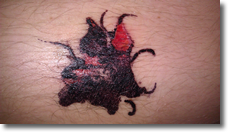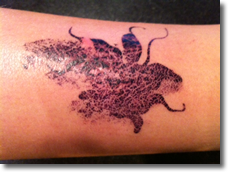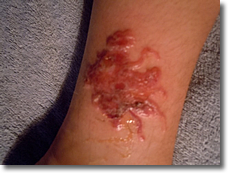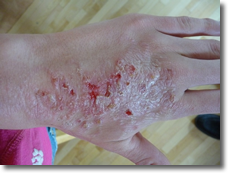Skin Lightening Products
- Skin Lightening Products Home
- Facts for the general public
- Facts for health care providers
- Urine Mercury Testing
- Community Outreach
- Public Awareness and Education Grant
- Additives Used in Henna Tattoo Materials
Related Sites
Environmental Health Division
Contact Info
Environmental Impact Analysis Unit
651-201-4899
Contact Info
Environmental Impact Analysis Unit
651-201-4899
Additives Used in Henna Tattoo Materials – Potential Health Concerns
Questions and answers
What is henna?
- Henna is red or brown dye that is typically derived from the dried leaves of the henna shrub (Lawsonia inermis).
- According to the U.S. Food and Drug Administration (FDA), henna is approved for hair dye only in the United States.
- Henna is used in direct application to the skin for temporary tattoos, in particular for decorating hands and feet.
- Dried leaves are ground into a fine powder and mixed with oil or water to make a paste which is applied to the skin. Allergic reactions from pure henna are rarely reported. It is not advised that henna be used in infants or young children.
What is black henna?
- Other ingredients can be added to henna to darken the color and lengthen the time that the tattoo is visible. This is referred to as “black henna.”
- One of the additives frequently used to make a darker color, is para-phenylenediamine, an ingredient in hair dye.
What is PPD?
- Para-phenylenediamine or PPD is not approved for direct use on the skin. PPD in cosmetics directly applied to the skin can cause allergic reactions and can result in intense itching, redness of the skin, blistering and in some cases scarring.
- Some individuals with skin reactions develop scars with lighter or darker patches of skin. Scars can last months or be permanent in some cases.
- Individuals who have sensitivity to PPD may have allergic reactions later on to substances that are similar chemically, such as hair dyes, sunscreens and medications.
What about other additives to henna?
Allergic reactions from the use of pure henna products on the skin have rarely been reported. A variety of other additives may be in a henna product and may cause an allergic reaction.
How do I know what is in a temporary tattoo product?
- Retail cosmetics must list ingredients on the label.
- The requirement for listing ingredients does not apply to products used exclusively by professionals for application at a salon, booth or fair.
- Consumers are advised to inquire what is in a henna product. Artists and vendors are advised to check with suppliers regarding the ingredients in a product.
When do reactions occur?
- A reaction may occur within 24-48 hours if a person has previously used products that contain PPD.
- Most reactions to “black henna” occur 4-10 days after the application, but reactions can occur up to 3 weeks later.
- Allergic reactions to other compounds may also occur quickly if there was a prior exposure or develop later (often within 10-14 days).
What can be done?
If a reaction is suspected, please see your health care provider. Consultation with a dermatologist may be helpful. In addition to a possible reaction to the product, it is important to check that there isn't an infection.
How do I report an adverse reaction to a temporary tattoo?
See the FDA Website for more information.
What do the reactions look like?
 |  |
 |  |
Last Updated: 01/09/2025